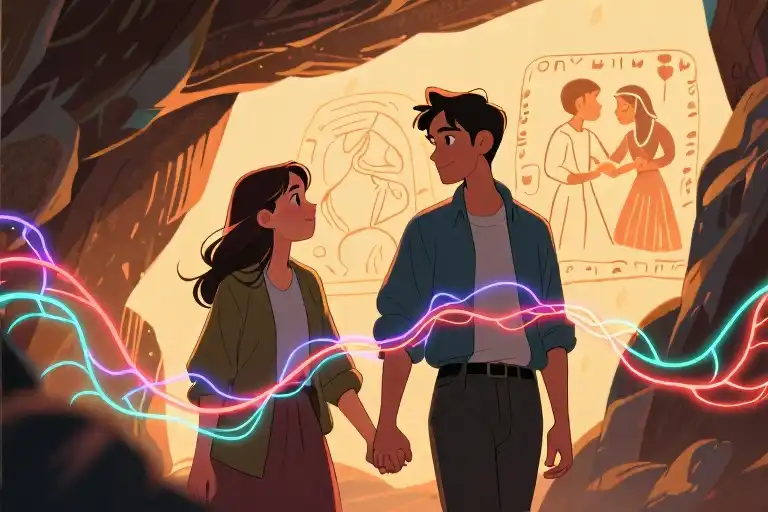The glow of your phone screen cuts through the darkness at 3:17 AM. You told yourself you wouldn’t do this again—wouldn’t unblock that profile, wouldn’t scroll through photos that now exist only as digital ghosts. Yet here you are, fingertips tracing the edges of their new life without you, searching for clues in cropped-out hands and half-empty coffee cups. “The heart’s first mistake is thinking it can undo what broke it,” the words echo as you click on a tagged photo from two weeks ago. Their smile looks familiar, but the context feels alien.
Why do we keep pressing salt into the same wound? There’s a peculiar madness in how humans return to emotional crime scenes, half-expecting the evidence to have rearranged itself. We revisit deserted battlefields hoping to find the war over, only to discover we’re still the only soldiers present. That midnight scroll through old messages isn’t curiosity—it’s a form of self-forensics, trying to pinpoint where exactly the love bled out.
The rational mind knows better. You’ve read the articles about dopamine withdrawal, could probably recite the stages of grief by heart. Yet some primal part of your brain still whispers those dangerous maybes: Maybe if they see how much I’ve changed. Maybe if we try one last conversation. Maybe time has rewritten the rules. This is how intelligent creatures become trapped in emotional loops—not from lack of understanding, but from an overactive imagination’s ability to repaint dead ends as undiscovered roads.
What makes these nocturnal rituals particularly cruel is how technology colludes with memory. Your thumb swipes left through a curated museum of highlights—that weekend trip, the birthday dinner, the candid laugh you caught mid-photo. The algorithm helpfully omits the fights, the silences, the growing distance that made the bed feel wider even when they were in it. Digital archives become accomplices in nostalgia’s con game, presenting selective evidence that convinces you the past was warmer than it ever actually was.
There’s a scientific term for this—rosy retrospection. Our brains aren’t storage units but editors, constantly rewriting history to make survival more bearable. The same mechanism that helps trauma victims recover also tricks heartbroken souls into misremembering. That’s why you recall the first morning they brought you coffee in bed, but not the last three months when they stopped asking how you took it. The human mind has an entire department dedicated to airbrushing reality, and it works overtime after loss.
Before you close that browser tab tonight, try this: Open your notes app and write three unfiltered truths about how it really felt at the end. Not the Instagram version, not the story you tell friends, but the raw, unpretty facts your body remembers—how your stomach knotted when their phone buzzed, how you started rehearsing conversations beforehand, how love began feeling like a language you’d forgotten how to speak. Keep this list where you’ll see it at 3 AM. The past may be a beautiful photograph, but healing begins when we stop expecting it to come back to life.
The Psychology of Returning to the Fire
There’s a particular kind of exhaustion that comes from repeating the same emotional mistake. You know the drill – unblocking that number at 2am, scrolling through archived photos until your thumb aches, rehearsing conversations that will never happen. These aren’t just bad habits; they’re neurological rituals wired into our survival mechanisms.
Five behavioral patterns reveal when we’re walking back into emotional fires:
- The Nostalgia Time Machine – Revisiting only the happiest memories while systematically deleting the painful ones from your mental hard drive
- The Investigator Phase – Compulsively checking their social media as if new posts contain secret messages about your worth
- The Bargaining Ritual – Creating elaborate “if only” scenarios where changing one variable magically fixes everything
- The Test Run – Manufacturing coincidental encounters to gauge their reaction (and your own)
- The Memory Hoarder – Treating every souvenir like a sacred artifact that might resurrect the relationship
Neuroscience explains why these behaviors feel simultaneously painful and necessary. During withdrawal from a bonded relationship, the ventral tegmental area – our brain’s reward center – lights up with the same desperate craving as substance addiction. Dopamine, the neurotransmitter associated with anticipation and desire, floods our system when we indulge in these rituals, creating a cruel paradox: the very acts that prolong our suffering also provide temporary relief from it.
This explains the fire metaphor with disturbing accuracy. The warmth we remember isn’t just emotional – it’s biochemical. Our cells literally ache for those neural pathways to reactivate, even as the rational mind screams warnings. Like moths drawn to flames, we confuse the light of memory with the promise of renewal, forgetting that fire only consumes what it touches.
What makes this cycle particularly vicious is how it mirrors trauma bonding patterns. The intermittent reinforcement – those rare moments of kindness in a generally painful dynamic – trains our nervous system to interpret anxiety as passion, and inconsistency as mystery worth solving. We become detectives of our own heartbreak, searching for clues we’ve likely planted ourselves.
Breaking this neurological spell requires recognizing these behaviors not as signs of devotion, but as symptoms of withdrawal. The same brain that tricks us into returning to harmful situations contains the tools to break free – but only if we stop mistaking the burning for warmth.
The Edited Reels of Memory: When Nostalgia Becomes a Beautiful Liar
We’ve all done it—scrolled through mental highlight reels of past relationships, watching edited versions where the pain fades to black while the good times play on loop. This selective memory isn’t accidental; it’s how our minds protect us from emotional whiplash. But like an Instagram filter on reality, nostalgia systematically removes the blemishes until we’re left with a distorted masterpiece that never truly existed.
Memory operates in three distinct phases when processing emotional experiences:
1. The Selection Process
Our brains automatically archive moments that trigger strong dopamine responses—the first kiss, the anniversary getaway, the inside jokes. Meanwhile, the silent treatments, broken promises, and lonely nights get stored in different neural folders, becoming harder to access over time. It’s not deception; it’s neurological efficiency. As one study from University College London found, positive memories form stronger neural pathways in the amygdala by nearly 40% compared to negative ones.
2. The Enhancement Phase
Like a cinematographer adjusting lighting in post-production, our minds begin enhancing certain details. The way their eyes crinkled when laughing stays in 4K resolution, while the way those same eyes avoided yours during difficult conversations becomes increasingly pixelated. Temperature plays a crucial role here—we remember the warmth of physical touch but gradually lose the chill of emotional distance. Try this test: On a scale from 1 (frozen) to 10 (sunbaked), what was the actual emotional temperature during your last month together? Most people realize they’ve been mentally averaging the entire relationship’s climate rather than recalling specific forecasts.
3. The Solidification Stage
After approximately six months, according to research in the Journal of Applied Cognitive Psychology, these edited memories become our new “facts.” The version where you both tried your best hardens into mental concrete, overwriting the raw footage where incompatibilities glared. This explains why we can simultaneously “know” a relationship was unhealthy yet “feel” intense longing for it—we’re craving a fictionalized past our brain has painstakingly produced.
Consider these common memory distortions:
| What Actually Happened | What We Remember |
|---|---|
| They forgot your birthday because they were distracted by work | They were just really stressed that month |
| The explosive fights that left you shaking | The passionate makeups afterward |
| Months of emotional unavailability | That one weekend they opened up |
This isn’t to say the good times weren’t real—they absolutely were. But when we allow nostalgia to become our sole archivist, we lose access to the complete documentary. The antidote isn’t cynical dismissal of past happiness, but rather conscious curation: keeping both the bouquet of roses and the record of how often they forgot to water them.
Neurologists call this “memory reconsolidation”—the process of updating existing memories with new information. Every time you deliberately recall both the sweetness and the sorrow, you weaken nostalgia’s grip. It’s why journaling from that period proves so unsettling; the unedited version contradicts the highlight reel we’ve been screening in our minds.
Here’s the paradoxical truth: The very mechanism that helps us survive heartbreak—this softening of painful edges—becomes the obstacle to moving forward. Like developing photos in a darkroom, we control how much light gets exposed to the negative. The question isn’t whether your memories are “true,” but whether the version you’re developing is helping you heal or keeping you stuck.
When you catch yourself replaying those sun-dappled mental clips, try inserting three minutes of raw footage—the unglamorous parts your mind has been omitting. Notice how your body reacts. There’s wisdom in that physical response; it remembers what your curated memories have tried to edit out.
Crafting Your Truth Compass
The moment you catch yourself romanticizing that first date while conveniently forgetting the three-month silent treatment — that’s when you need this toolkit. We don’t heal by willing our memories into kinder versions of themselves. Healing begins when we stop letting nostalgia autotune our past.
7 Signals You’re Editing Reality
- The Highlight Reel Syndrome (对应原文”not how they stopped looking altogether”)
When you mentally replay only the good morning texts but erase the ignored emergencies. Your brain has become a cinematographer, cutting all scenes where you weren’t the protagonist. - The Temperature Paradox
Remembering the warmth of shared blankets but not the icy silences (原文”forget how cold it got”). Like recalling a vacation’s sunshine while denying the food poisoning that ruined two days. - The Time Warp
“We were happy for years” actually meant three good months followed by slow disintegration. Human memory compresses duration like a faulty ZIP file. - The Character Redemption Arc
Believing they’ve fundamentally changed because they liked your Instagram story. Real change doesn’t announce itself in social media breadcrumbs. - The Blurred Boundaries
Calling midnight “just checking in” texts “progress” when they still avoid daylight accountability. Fire doesn’t become less hot when it burns you after dark. - The Deleted Scenes
Your friends still tense up at their name, but you’ve memory-holed why. When multiple people recall the same events differently, someone’s editing. - The Reboot Fantasy
“Maybe if we meet at that café where we first…” (原文”Maybe…”排比). Relationships aren’t software — you can’t CTRL+Z your way back to version 1.0.
Cognitive Fire Drill: The 3-Step Interruption
When nostalgia starts its director’s cut:
- Freeze Frame
Physically pause (set a 90-second timer). Your brain can’t sustain emotional illusions under time pressure. - Audio Commentary
Speak aloud: “Right now I’m remembering , but not ” (fill both blanks). Hearing your own voice disrupts the mental montage. - Scene Rewrite
Replace with one verifiable fact: “They canceled our anniversary plans claiming work, then posted bar photos” beats “They were just stressed.”
The 21-Day Exposure Therapy
Print this page and:
- Morning
Circle which signals appeared yesterday (even faintly) - Evening
Write one raw truth about the past you’ve been avoiding (Example: “Their ‘quality time’ meant me watching them scroll”) - Progress Marker
When you notice yourself thinking “But what if…”, add a tally. Not to judge, but to see the obsession fade like an old photograph (原文隐喻呼应).
This isn’t about hating your past. It’s about stopping the mental time travel that leaves you jet-lagged in the present. That photo album? Let it stay on the shelf while you build something new with both eyes open.
The Museum of Memory
There comes a moment when the photograph must leave your wallet. Not discarded, not destroyed, but placed gently in the archives where it belongs. That image of what once was – the light catching their smile just so, the background blurred in that perfect way – deserves preservation, not daily handling. Your fingers have left smudges on the glass from too much revisiting.
This is the quiet work of emotional healing after breakup: learning to curate your past with the precision of a museum director. Some artifacts go in climate-controlled display cases with careful lighting. Others belong in storage drawers, accessible but not constantly visible. The most fragile pieces may need special handling instructions – “View only with emotional support present” or “Limit exposure to 10 minutes per month.”
Consider this your invitation to begin the cataloging process. Take out that mental “truth list” we’ve been compiling through these chapters. The one where you finally wrote down:
- How often the silences lasted longer than the conversations
- The exact shade of blue your cheeks turned waiting by the phone
- The number of times “maybe” turned out to mean “no”
These aren’t accusations. They’re simply the provenance records every good museum keeps – the documentation that tells the full story of an artifact’s journey. A photograph without its provenance is just a pretty picture. A memory without its full context is just nostalgia’s beautiful lie.
So let’s perform this final ritual together:
- Find one physical object connected to this exhibit (a ticket stub, a screenshot, that sweater)
- Hold it while rereading your first completed truth list
- Say aloud: “This belongs to a past that shaped me but doesn’t define me”
- Choose its appropriate museum placement (wallet? memory box? digital archive folder?)
You’ll know the work is done when you can look at the photograph and see not just what was lost, but what was learned. When the warmth of the memory no longer burns with the heat of recent embers, but glows like carefully preserved amber. When you understand that letting go of the past isn’t about forgetting – it’s about finally seeing clearly enough to remember truthfully.
That smoke you’ve been noticing around the edges of your memories? It was always there. The fire just had to cool enough for you to see through the haze. Now tell me – what’s the first exhibit you’ll place in your new museum of truth?





